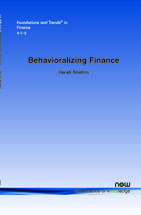Behavioralizing Finance
By Hersh Shefrin, Mario L. Belotti Professor of Finance, Leavey School of Business, Santa Clara University, USA, hshefrin@scu.edu
Abstract
Finance is in the midst of a paradigm shift, from a neoclassical based framework to a psychologically based framework. Behavioral finance is the application of psychology to financial decision making and financial markets. Behavioralizing finance is the process of replacing neoclassical assumptions with behavioral counterparts. This monograph surveys the literature in behavioral finance, and identifies both its strengths and weaknesses. In doing so, it identifies possible directions for behavioralizing the frameworks used to study beliefs, preferences, portfolio selection, asset pricing, corporate finance, and financial market regulation. The intent is to provide a structured approach to behavioral finance in respect to underlying psychological concepts, formal framework, testable hypotheses, and empirical findings. A key theme of this monograph is that the future of finance will combine realistic assumptions from behavioral finance and rigorous analysis from neoclassical finance.
Behavioralizing Finance
Behavioralizing Finance suggests that finance is moving to a new paradigm that combines structural features from neoclassical finance and realistic assumptions from behavioral finance. The behavioralization of finance involves intellectual shifts by two groups – the first shift features neoclassical economists explicitly incorporating psychological elements into their models and the second shift features behavioral economists developing a systematic, rigorous framework. Behavioralizing Finance starts by describing the highlights of the behavioral finance literature and identifying some of the weaknesses of this literature. The remainder of the volume has two main objectives: To discuss works which have emerged since the past surveys appeared, or which those surveys overlooked for one reason or another; to present some ideas about trends toward a unifying framework for behavioral finance that captures some of the rigor in neoclassical finance. Behavioralizing Finance provides a structured approach to behavioral finance in respect to underlying psychological concepts, formal framework, testable hypotheses, and empirical findings. A key theme of the volume is that the future of finance will combine realistic assumptions from behavioral finance and rigorous analysis from neoclassical finance.
